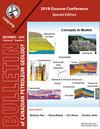碳酸盐岩沥青岩溶储层中天然裂缝网络的组织、流动影响和建模:以加拿大阿尔伯塔省Athabasca Saleski油田Grosmont组为例
Q3 Earth and Planetary Sciences
引用次数: 7
摘要
阿尔伯塔省的格罗斯蒙特组是世界上最大的碳酸盐岩储层之一。这也是一个高度裂缝性的油藏,天然裂缝网络对产量和最终采收率有着关键的影响。目前的裂缝研究主要集中在Saleski租地的Grosmont C和D单元,Laricina Energy Ltd.及其合作伙伴Osum Oil Sands Corp.于2010年启动了Grosmont的蒸汽注入试验。该研究旨在表征储层单元中裂缝的类型、规模和组织,以建立具有代表性的裂缝模型,并得出相应的裂缝特性,用于双孔隙度动态模拟。详细的岩心和井眼图像分析显示,Grosmont C和D单元的压裂被组织成四组米尺度的节理和各向同性的厘米尺度溶蚀相关裂缝。节理密度受相控制。动态数据分析揭示了泥浆损失、岩石溶蚀和相类型之间的联系,特别是在中D单元。它还强调了裂缝对储层整体渗透率的贡献。所有这些发现都被整合到一个多尺度裂缝模型中,一旦进行动态校准,就可以计算裂缝孔隙度、渗透率张量和基质块尺寸。这些输出对于热双重孔隙度动态模拟至关重要。本文章由计算机程序翻译,如有差异,请以英文原文为准。
Organization, flow impact and modeling of natural fracture networks in a karstified carbonate bitumen reservoir: an example in the Grosmont Formation of the Athabasca Saleski leases, Alberta, Canada
Abstract The Grosmont Formation in Alberta contains one of the largest hydrocarbon accumulations of a carbonate reservoir in the world. It is also a highly fractured reservoir, where natural fracture networks have a key bearing on production and final recovery. The present fracture study focused on the Grosmont C and D units of the Saleski leases, where a steam injection pilot for the Grosmont was initiated in 2010 by Laricina Energy Ltd. and its partner, Osum Oil Sands Corp. This study aimed at characterizing the types, scales and organization of fractures in the reservoir units in order to build a representative fracture model and derive corresponding fracture properties to be used in dual porosity dynamic simulations. Detailed core and borehole image analyses revealed that fracturing in the Grosmont C and D units is organized into four sets of metre-scale joints and isotropic, centimetre-scale dissolution-related cracks. The joint density is controlled by facies. Dynamic data analysis revealed a link between mud losses, rock dissolution and facies types, especially in the Middle D unit. It also emphasized the fracture contribution to overall reservoir permeability. All of these findings were integrated to build a multiscale fracture model which, once dynamically calibrated, allowed computing fracture porosity, permeability tensor and matrix block sizes. These outputs are critical for thermal dual porosity dynamic simulations.
求助全文
通过发布文献求助,成功后即可免费获取论文全文。
去求助
来源期刊

Bullentin of Canadian Petroleum Geology
Earth and Planetary Sciences-Geochemistry and Petrology
CiteScore
2.50
自引率
0.00%
发文量
0
期刊介绍:
The Bulletin of Canadian Petroleum Geology is a peer-reviewed scientific journal published four times a year. Founded in 1953, the BCPG aims to be the journal of record for papers dealing with all aspects of petroleum geology, broadly conceived, with a particularly (though not exclusively) Canadian focus. International submissions are encouraged, especially where a connection can be made to Canadian examples.
 求助内容:
求助内容: 应助结果提醒方式:
应助结果提醒方式:


